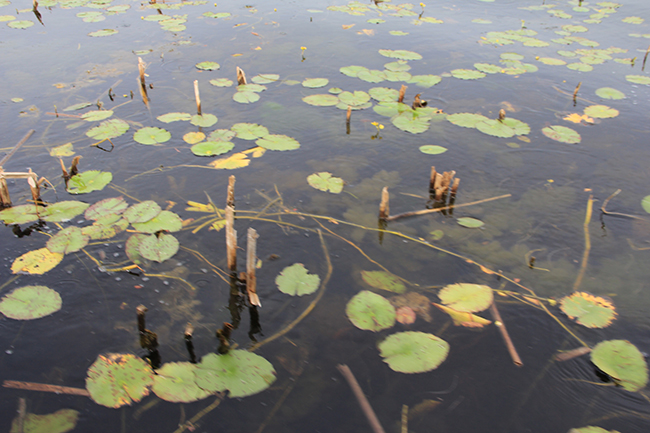Lake O Pits And Joins Unusual Forces
By Zarrin Ahmed
The water level in Lake Okeechobee is so important to South Florida that arguments break out over it.

Photo by Kaitlyn Carroll.
Those who control flooding and environmentalists concerned about the health of the lake want to lower the water level. Meanwhile many farmers and environmentalists concerned about the Everglades downstream want to raise it.
Paul Gray, science coordinator for Audubon Florida, is in the middle of these disputes. While he considers himself an environmentalist, he finds himself at times arguing with other environmentalists. “Some of them say, ‘Well, why don’t we sacrifice Lake Okeechobee to make the Everglades work better?’” said Gray. “But that’s the thing about restoration. We’re not trying to lose one environment to another.”
The water used to naturally overflow Lake Okeechobee during the wet season, moving south because of the lake’s gradual slope, and into the Everglades. But development just south of the lake now prevents that water from naturally reaching the Everglades.
A system of dikes and levees control the water level of the lake while canals and pumps channel the water to farmers, into the ocean, and only some goes into the Everglades.
Concerns about the lake’s uncontrollable water levels date back to a 1928 hurricane. The storm flooded the area south of the lake and caused nearly 2,000 deaths. With such devastation from the hurricane, the Florida legislature cooperated with the United States Army Corps of Engineers to create the Okeechobee Flood Control District.
The primary goal was to create a long-term system of floodway channels, canals, levees, and control gates that would provide flood control, and other measures including building the Herbert Hoover Dike. Completed in 1938, it is now 140 miles in length and almost entirely surrounds the lake.
That was followed by the creation in 1949 of the South Florida Water Management District, which was created to oversee the water resources in the southern half of the state. Their duties include balancing and improving water quality, flood control, and water supply for the eight million people in South Florida.
It’s these residents that flood control proponents want to protect. By keeping the water level low, there would be no repeat of the events in 1928. To prevent flooding, residents and politicians want the water levels to remain low so that no damage is caused in case of a hurricane.

Photo by Kaitlyn Carroll.
But farmers, who are affected by droughts, have other concerns. To have enough water, many sugar farmers rely on Lake Okeechobee to provide the fresh water necessary to grow crops. They want to keep the water levels in the lake high in case of drought. If there isn’t enough rainfall to sustain their crops, the stored water would prevent a loss of product.
Some environmentalists such as Gray at Audubon Florida want to conserve and restore the natural state of Lake Okeechobee. When the lake functions at its best, when it is able to overflow freely and support natural wildlife during droughts, it is home to many species of wildlife.
Other environmentalists want the Everglades to get more water from Lake Okeechobee. In this case, the water levels need to remain high in order to supply the area even in times of drought.
With water levels averaging between 10 to 13 feet in depth, the natural state of Lake Okeechobee is a fragile one. When the dynamics are not too low, nor too high for too long, the lake thrives. But for the lake’s ecosystem, the water level isn’t the only determinant for its success: the water quality is too.
Gray often works with Don Fox, a fish biologist for the Florida Fish and Wildlife Conservation Commission, who is trying to rehabilitate the vegetation within the lake. When runoff from farmlands seep into the waters, Lake Okeechobee undergoes changes that affect the natural ecosystem. Phosphorus is the main concern, Gray and Fox say, and it has the potential to ruin the lake for years to come.

Photo by Maschal Mohiuddin.
Lake Okeechobee, like the rest of South Florida, has very fragile soil that is almost like sand. The water itself is fragile, unable to handle rich nutrients like phosphorus.
“What we’re doing now is building some ecological resilience into the lake,” said Fox.
Fox has a green thumb and grows plants along the northwestern edge of the lake, building tree islands that are suitable for wading and migratory birds. He uses herbicides to kill invading species like cattail, which outgrows the native sawgrass. He also tries to prevent invasive species from outcompeting natural species and changing the landscape of the lake
In contrast, the center of the lake, particularly, is stripped of plants and remains far more polluted.
As more attention is paid to the Everglades, the debate about Lake Okeechobee has been rising in volume.
“When that flood control system was completed back in 1972, there were roughly a million people in a 16 county area,” said Gary Ritter of the South Florida Water Management District. Now there are eight million. “So you can understand the challenge we have in trying to manage the resource not only for environmental purposes, but to supply the eight million people that we have in South Florida, or help maintain the integrity of the water supply system.”